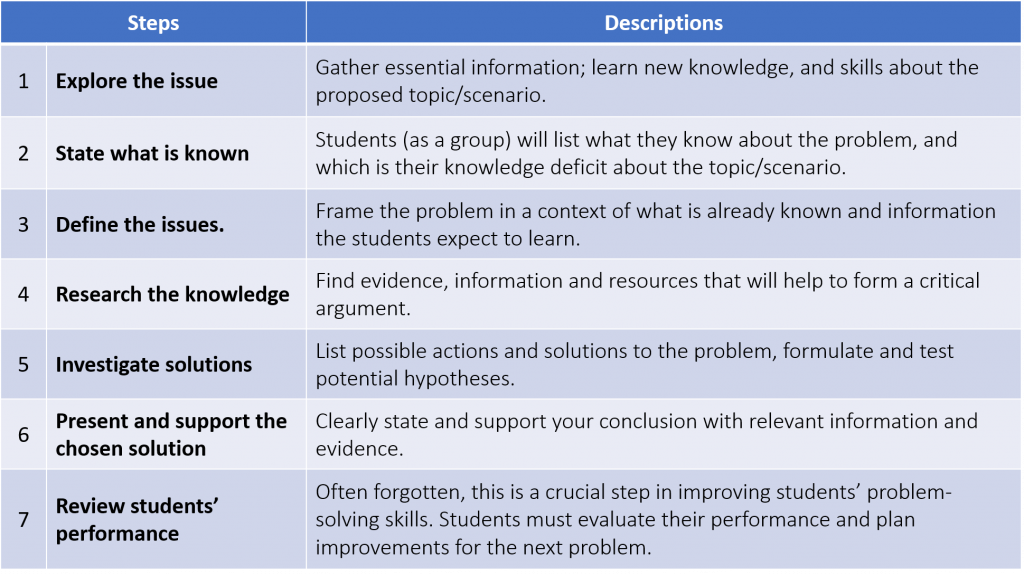The following methods can be used to conduct in-class activities.
Team-based learning
Team-based learning (TBL) is a useful group-based learning approach that can be scaled up for conducting in large-sized classes.
Easy three steps for conducting TBL:
- Individual preparation for in-classroom activities: The individual learning is undertaken before the face-to-face class. It is same as the process that happens in pre-class in the Flipped classroom.
- Readiness assurance: The readiness assurance is measured through using the following two methods:
- Individual Readiness Assurance Test (iRAT): Students first attempt an individual closed-book knowledge test (typically consisting of 15 to 25 multiple choice questions) to assure whether their understanding of the pre-learning materials is sufficient or not.
- Team Readiness Assurance Test (tRAT): Student attempts the above same closed-book knowledge test as a team in a small group of 5–7 students. Here, students discuss their individual answer and rationale with others and come to a consensus with group. The group discussion often generates additional “burning questions” regarding the topic. Teachers give their facilitation to solve the burning questions.
- Application of the learnt concepts: Here, small groups are given a series of exercises through clinical scenarios/problem for applying the learnt concepts. First, students discuss within group and come up with solutions. Then, solutions will be discussed between groups. Teacher facilitates the class-wide discussion and may provide expert opinions.
Problem-based learning
Problem-based learning (PBL) enable the learners to work with other students as a team and solve the complex problem by using pre-existing knowledge.
Easy seven steps to a PBL:

Case study
Students investigate a case study regarding diseases or real-life problems or a specific scenario.
Applying what they learned in the pre-class portion of the flipped classroom, the group will discuss how they would tackle the problem and what solution they would prepare.
Each group can then debrief with the rest of the class and present their solution.
Think-pair-share
Take the main theme presented in the pre-class material or a particularly debatable quiz question from a pre-class assessment or diagnostic test, and have students reflect on it individually and then discuss it further.
- Think phase: students start to work individually and independently. Then flesh out their thoughts/arguments and may write their thoughts down.
- Pair phase: students discuss their response with a partner
- Share phase: the teacher prompts responses from all students in the classroom and begins to engage students in a wider discussion demonstrating the many different perspectives. Online dashboard in LMS may be useful in the sharing phase.
Fishbowl discussion
A small group of students seated in a circle and engage in a peer-mediated discussion (with teachers’ facilitation if necessary).
The remaining students can sit in a larger circle and watch the discussion, taking notes and critiquing the content and logic of the discussion.
The outer circle can then discuss the interaction that occurred and provide additional insight into the topic and provide constructive feedback.
Three-step interview
- Students are initially grouped into pairs where each student takes a few minutes to interview the other about the material that was studied in a pre-classroom.
- Students come up with questions they would like to ask, and after each member in the pair has interviewed the other, the pair summarises their partner’s responses
- Then, shares a group responses with another pair of students.
Roleplay
Roleplay can be facilitated in class to demonstrate varying perspectives on a topic.
Students assume different roles in small groups and act out the parts with the varying perspectives they would have.
After the roleplay, conclude with a more extensive discussion to see what approaches the groups, or individual members took.
Reaction sheets
Choose a number of broader, overarching questions based on pre-class material.
Divide the class into small groups and give each group one of these questions and a large piece of paper to record their responses.
Each group spends ten minutes to write everything that comes to mind in relation to the topic.
When the ten minutes is up, each group moves to another table and leaves the paper with the question and their responses on it behind.
At their new tables, groups review the question and the comments which have already been recorded and add additional comments.
After each group has added comments to all other groups’ questions, they return to the initial question, review the additional comments provided, and summarize to the entire class.
This activity is useful for solidifying understanding of a special topic or a threshold concept that the entire class needs to understand properly.
Critical debate
Choose a controversial topic and determine what side of the argument the students would be in favour of during the pre-class task.
Once in class, separate the students into groups based on their alignment and have them argue for their chosen position.
Have students in each group choose specific roles in the debate process, and after having sufficient time to prepare an argument (thirty minutes or so), have each group pair up with a group of the opposing viewpoint and engage in a debate.
Afterwards, synthesise the various points of debate in a more extensive class discussion.